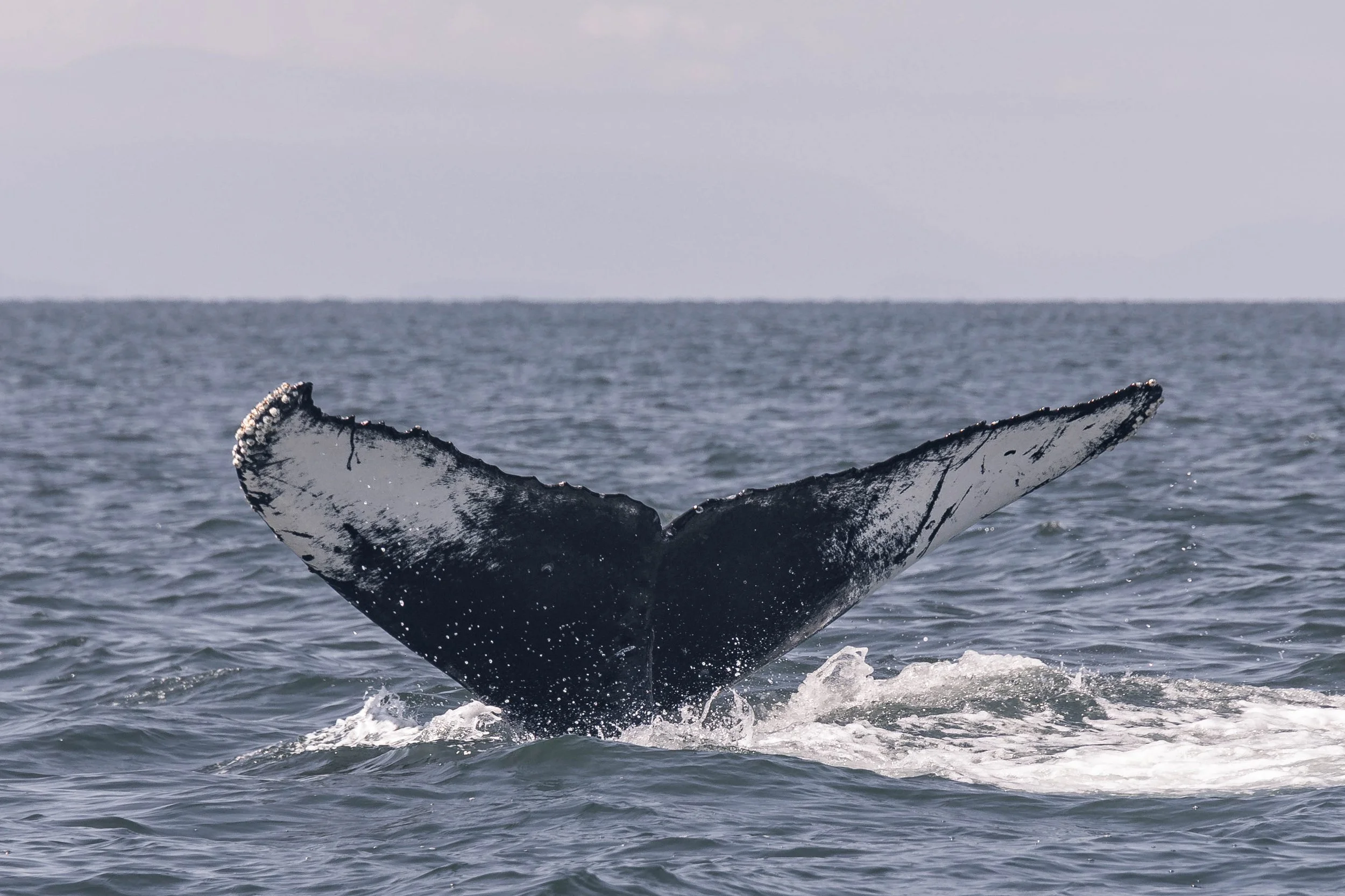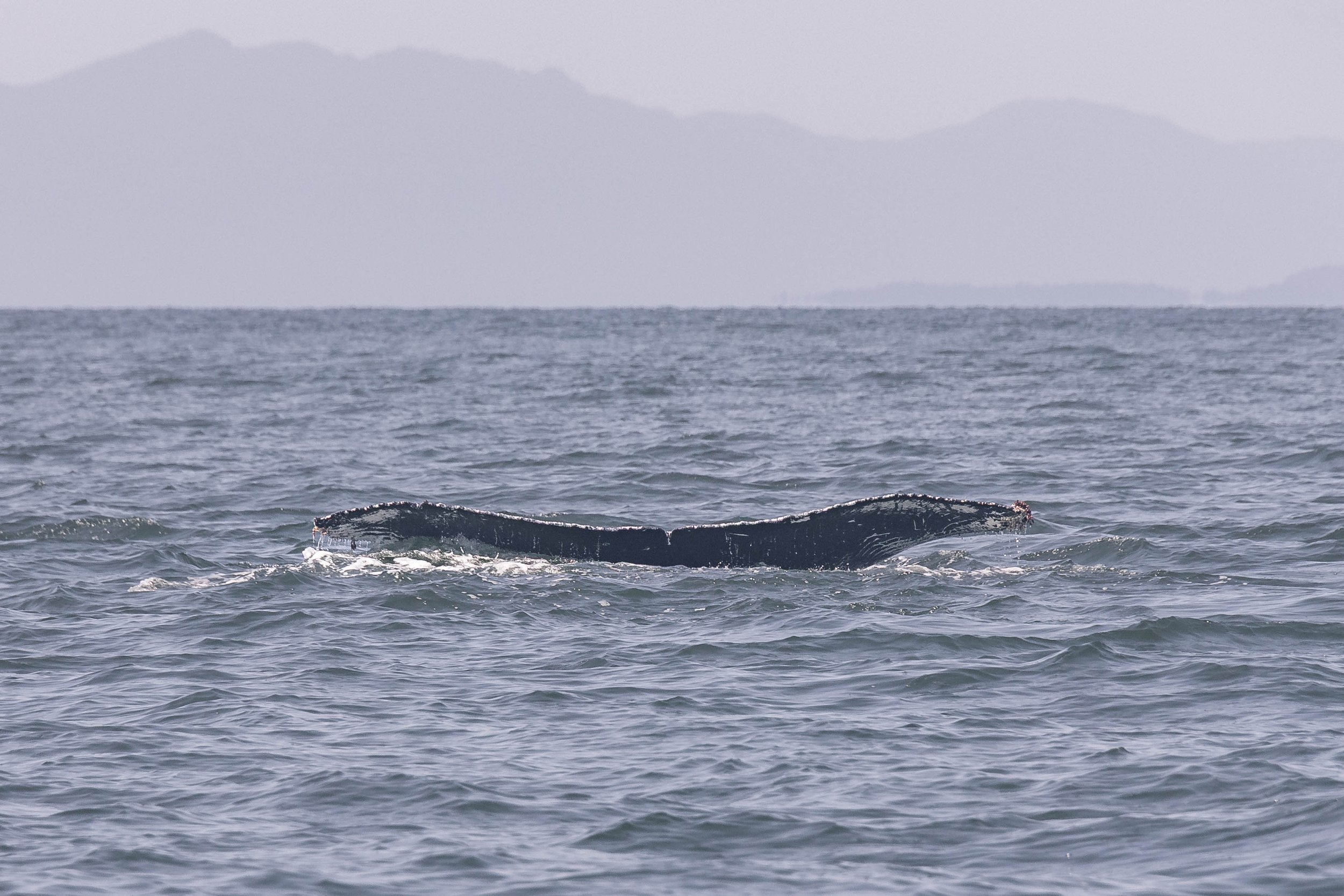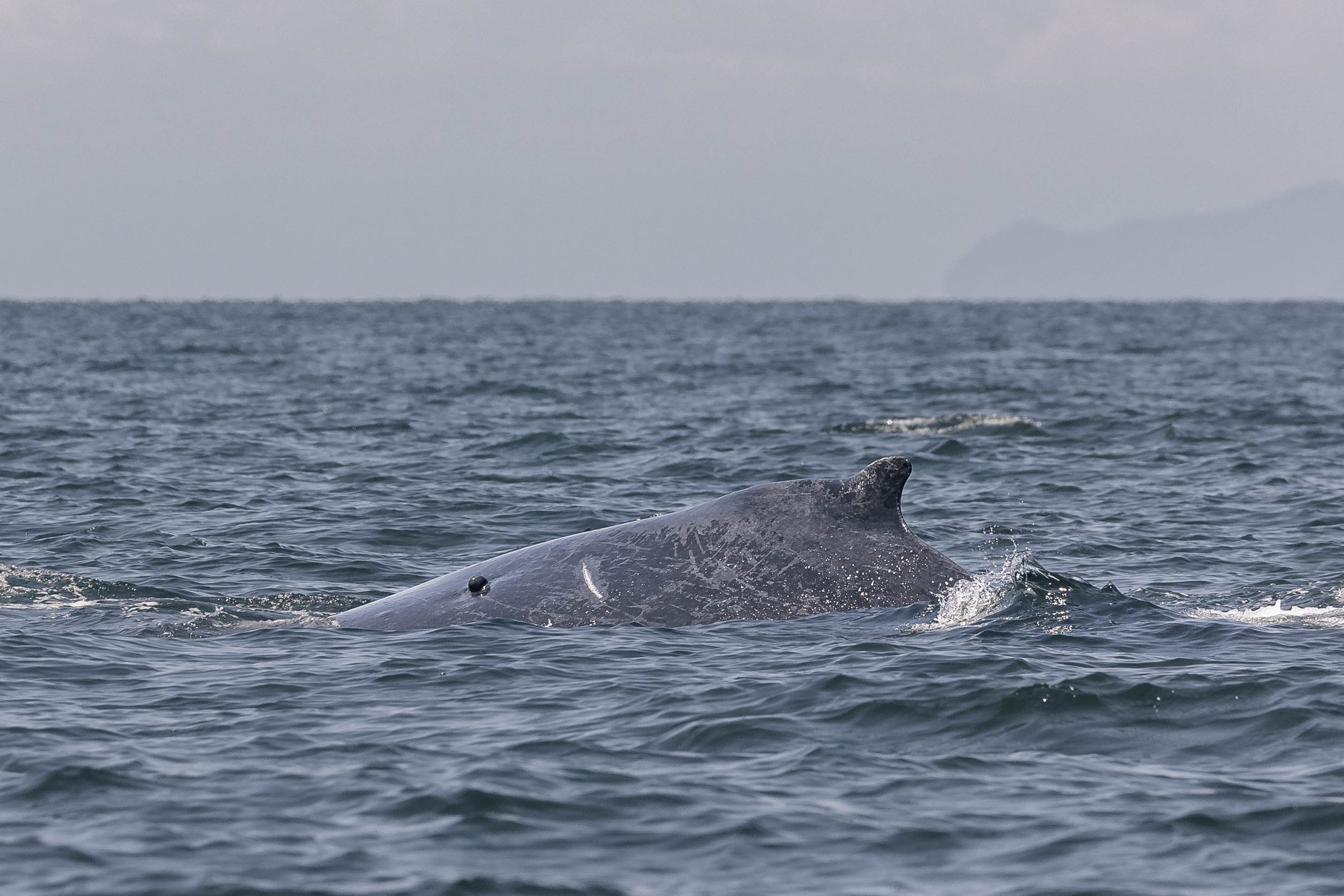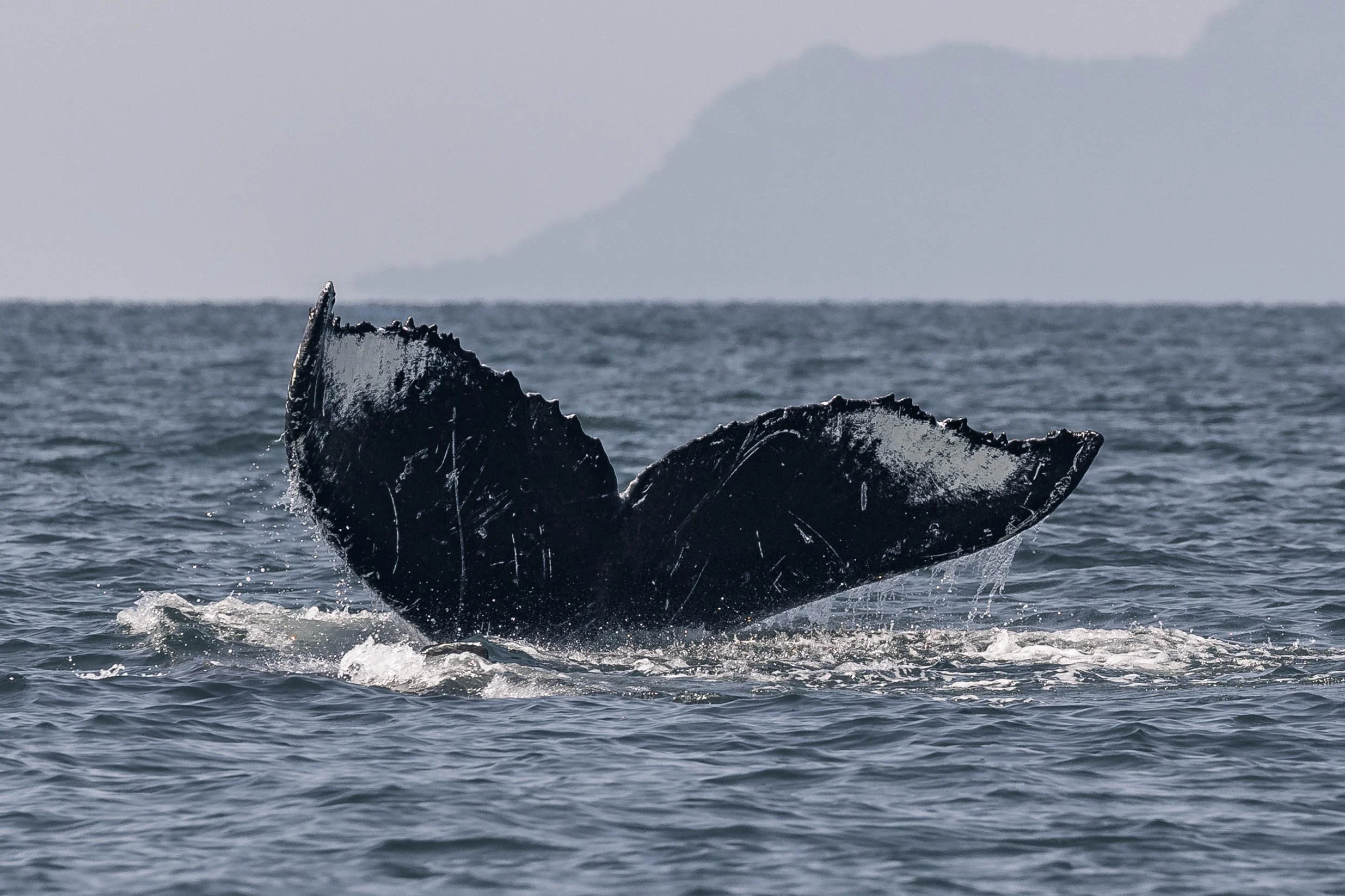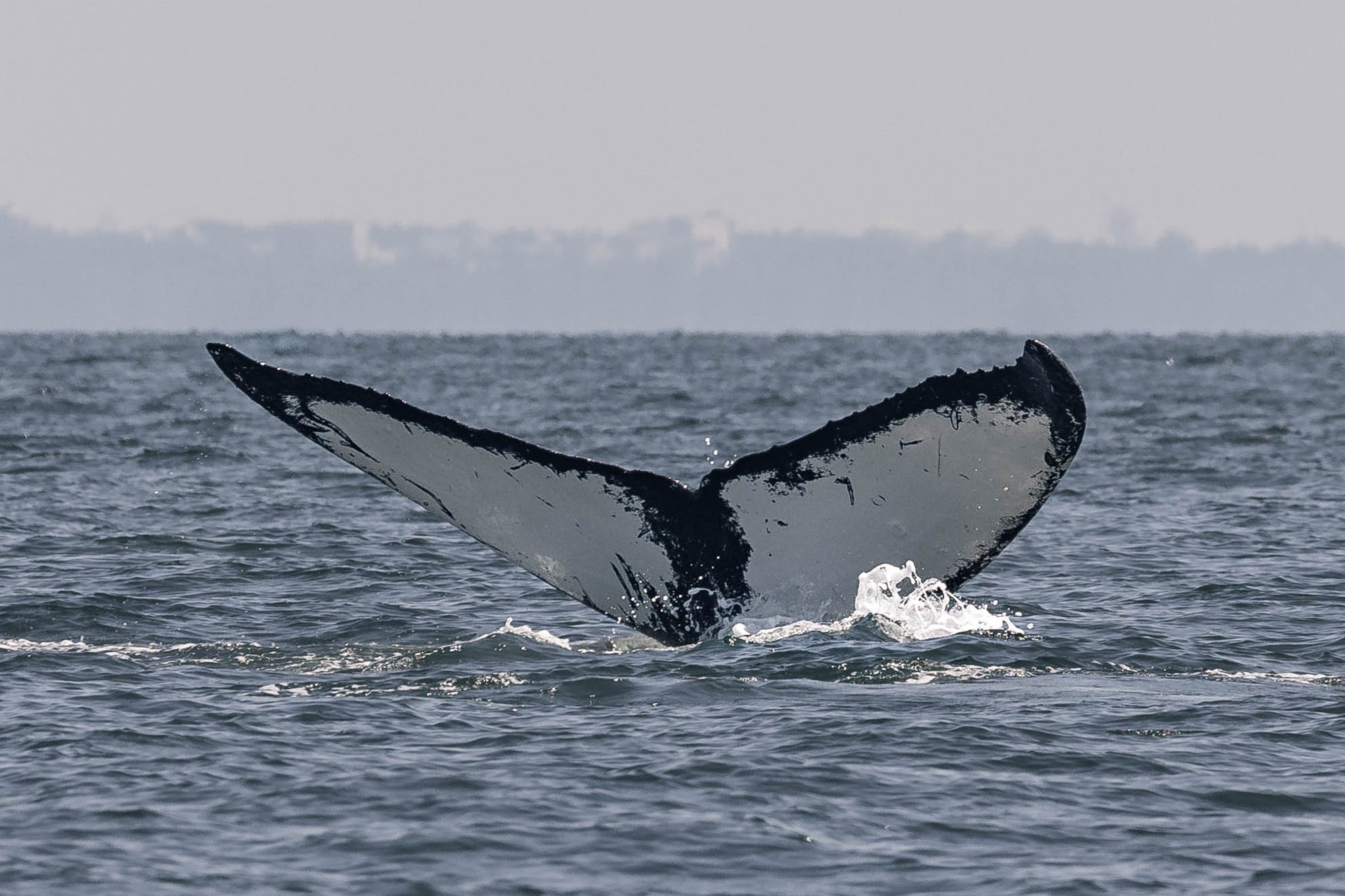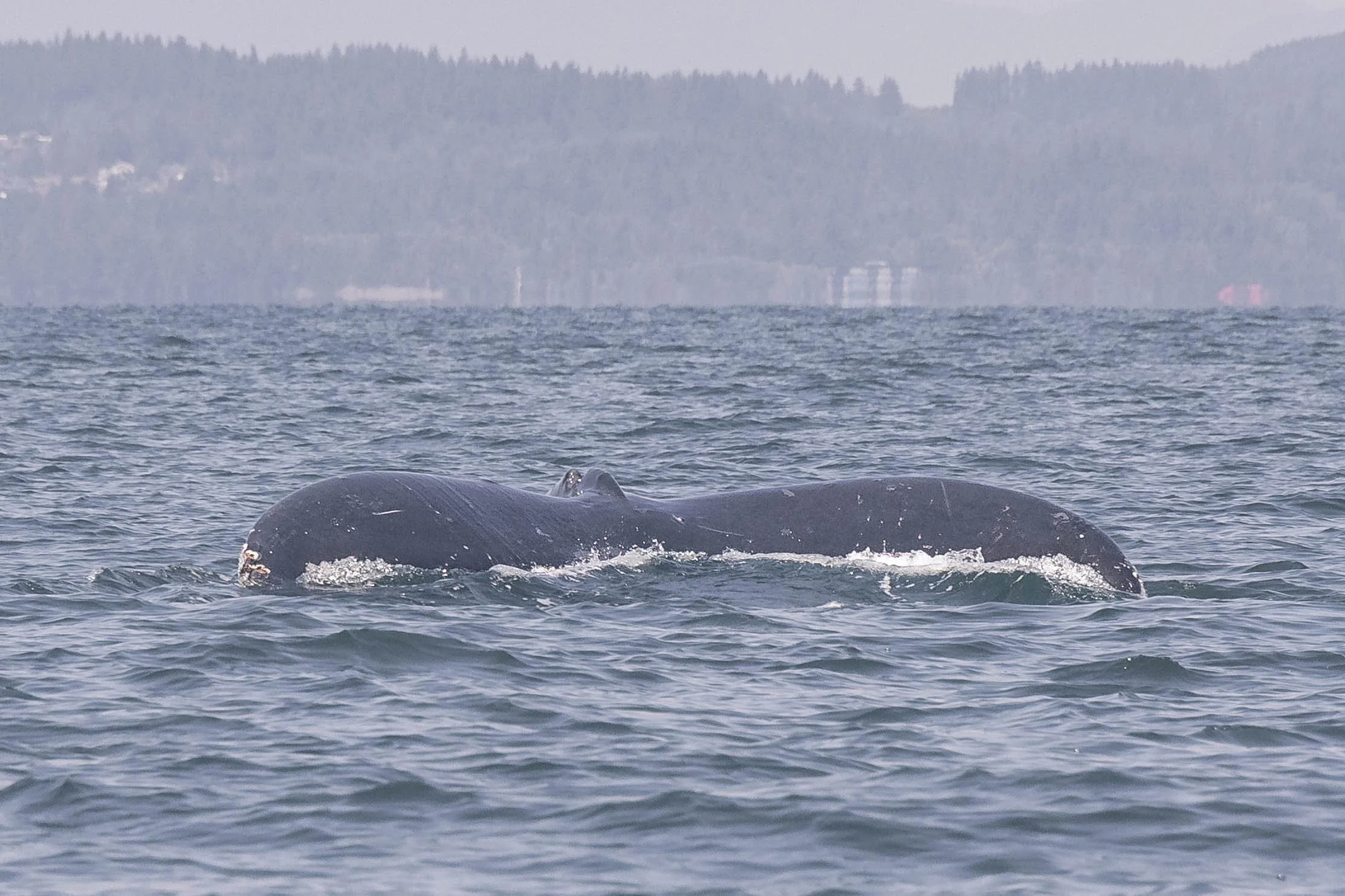July 20, 2025, 10:30 AM - T123s at Duke Point, and a gaggle of Humpbacks in the Strait!
Pushing off the dock, we were eager to start our search. While we never truly know where our whales will be from day to day, we had heard word of a potential orca sighting close to the Duke Point ferry terminal shortly before our trip departed. We excitedly started scanning the second we left the dock, peering left and right, looking for the tell-tale signs of whales nearby. For our orca, typically we are looking for their dorsal fins (the giant fins on the top of their bodies), their saddlepatch (greyish area behind the dorsal fin), their blows (tall spouts that look similar to smoke rising off the surface of the water), or their eyepatches (white ovular shapes on either side of their faces). It is beneficial if there is a large male present in the group, as their dorsal fins can get up to 6 ft. (1.8 m.) tall!
Thankfully, this matriline happened to have one of those massive males nearby! Once we had spotted them, we got into position, and our Naturalists began snapping photos to confirm their identities. Things such as notches along the trailing edge of the dorsal fin (3 of these 4 had these), dorsal fin shape, and scratches in the saddle patches can all be cross-matched against the Transient Orca ID Catalogue to confirm who’s who.
Once we had a couple of photos, we were able to confidently ID this pod. These four whales were identified as the T123s:
T123 Sidney ♀ (~1985)
T123A Stanley ♂ (2000)
T123C Lucky ♀ (2012)
T123D Darcy ♀ (2018)
The T123s are a relatively common pod in the area, so much so that the eldest son, Stanley, got his name from the famous park in Vancouver!
Stanley is famous for another reason as well. His particular notch and dorsal shape is very similar to another mature male… named Yelnats! Can you see how Yelnats got his name?
Even more interestingly, the two matriarchs of these pods, T060 Panthera and T123 Sidney, also have very similar fins, and both pods have four members travelling together (though the T060s have two living brothers that have travelled separately for several years now). Thankfully, the youngest member of the T123s, T123D Darcy is pretty distinct and helps us confirm which pod we are with if we are ever second guessing!
T060C Yelnats vs. his catalogue photo.
T123A Stanley vs. his catalogue photo.
This rambunctious family was travelling northbound as we observed them, crossing Nanaimo’s Outer Harbour and continuing their way up the island’s coast. They didn’t seem to have anything particular going on as we watched, as they busily travelled along. These massive predators spend a considerable portion of their days traversing from place to place, often bouncing from pinniped haulout to haulout in search of easy meals. While travelling, the family members would move closer and further away from each other, occasionally coming together to travel side-by-side as they continued their travels northward.
After enjoying our time with the T123s, we headed back out, once again entering search mode - this time looking for our other whale species, the Humpback! With many humpbacks being spotted in the Strait of Georgia, there was a good chance we would locate one or two… but instead, we found eight different whales over five different encounters!
Our semi-covered vessel Kula’s first humpback of the day was a smaller whale travelling southbound along Halibut Bank. They were being very cooperative, and we were able to get a good fluke from them to identify them. With this, we confirmed they were with Thunderbolt (KEY0064), the 2023 calf of Strike (BCX1675). Strike has also been seen in our area a couple of times recently, a testament to the strength of site fidelity in this species. Humpback calves will spend roughly a year by their mother’s side before they depart to start travelling the seas solo. During this time, the young calf will learn both directions of their migration route, as well as other important details such as the safest routes to take and the best places to forage for food in their feeding grounds. Site fidelity is a term used to describe the tendency for an individual to return to areas they have previously been in, and this tendency tends to be very strong in Humpbacks. Almost all calves are documented returning to the same breeding grounds and feeding grounds that their mothers taught them about.
While Kula was observing Thunderbolt, our open vessel, Cascadia, had spotted a pair of humpbacks of their own. These two appeared to be napping and were not fluking much while we were watching. This normally could pose an issue for identification purposes, as we usually use the underside of their tails to confirm their identity. Still, luckily, one of these two had a very unique dorsal fin with a large circular scar on one side. From this unique dorsal, combined with a slightly off-angle fluke photo, we confirmed these two were Split Fluke (BCX1068) and her 2025 calf (BCX1068 calf 2025)! Her calf appears to have quite a bit of scarring on its dorsal already, and depending on how it heals, we may end up using these scars to identify them too as they grow up.
Kula left Thunderbolt, then continued onwards, and it wasn’t long until they found another two humpbacks! They had located a mother-and-calf duo of their own. This mother had a very unique dorsal fin shape, being very flat on top, with a number of unique scratches and scrapes on it as well. With this, we identified her as Graze (BCY0523), travelling with her 2025 calf (BCY0523 calf 2025). Ironically, Graze is well-known as a “non-fluker”, as in nearly every encounter with her, she refuses to lift her tail up. Surprisingly, today she did just barely lift the edge of her flukes out of the water! Graze’s lack of fluking over numerous encounters spanning multiple years could indicate she may have damage to her peduncle (the muscular section that connects the body to the flukes), which may mean fluking is difficult for her. Her name also originates from numerous rake marks all over her fluke and pectorals, likely from an orca attack when she was very young, which could be the reason for her lack of fluking now. Whatever the case, she still seems to be flourishing, as she keeps bringing healthy babies back with her to our area!
At this point, Cascadia had left Split Fluke and her calf behind and had once again stumbled onto ANOTHER pair of humpbacks! This pair was travelling side-by-side, occasionally fluking and defecating (pooping) as they dove! We grabbed fluke shots of these two and identified them as Orion (BCX1251) and Anvil (BCZ0410) - Anvil is another whale that we can ID a bit differently from most whales, though! If you peek at our photos below, you might notice that she has a large bump on her left side, just ahead of her dorsal fin. This is scar tissue from an old satellite tag! These scars happened because Sat tags used to be attached by small darts that would lodge into the skin of the whale. There aren’t very many whales in our area that have these scars, so they are another identifiable feature we can use to confirm who we are watching!
You’d think after this many whales had been sighted, we would be wrapping up for the day, but that wasn’t the case! Kula spotted one more lone humpback to wrap up the trip, topping us up with a total of 12 different whales observed throughout the trip between the two boats!
Similarly to Graze, Split Fluke, and Anvil, this humpback could also be identified unconventionally. While they dove, a large notch shape was visible on the top of this whale’s peduncle, close to the flukes. This whale was Scuba (BCY1225), and his notch was because of a previous entanglement. Entanglement, or getting wrapped up in any kind of debris, is a serious concern for our humpbacks. It can cause lacerations, infections, and potentially be fatal if left unattended. Scuba was able to shed his gear naturally, but sometimes trained professionals are needed to step in and help disentangle our gentle giants. Besides taking photos of the whales for identification, we also use these photos to make sure we don’t spot anything attached to the whales in case we need to call for assistance. If you are ever observing whales in our area and you spot something unnatural attached to them, please report it to the BC Marine Mammal Response Network (Observe, Record, Report) at 1-800-465-4336!
Once we wrapped up our last whale encounters, we headed out to try to find other wildlife to enjoy! We zipped over to the Halibut Bank ODAS buoy to see if we could spot anything there. Today, several Steller Sea Lions were dozing, sprawled all over the marker. These buoys are favourite haulouts for our pinnipeds, as they are always at the surface of the water, regardless of tides! At this point in the year, there aren’t too many sea lions still hanging around, so seeing them piled up together like this is a real treat!
To finish off the trip, we took one more short visit over to the Gabriola Bluffs to see if we could spot some birds. Besides the usual Cormorants roosting against the rocks, we also spotted a Bald Eagle at the top of the trees, and a Turkey Vulture soaring by!
Please enjoy these photos taken by Marine Naturalists Hayleigh Hilbert and Desarae Poier!
T123C Lucky zooming by. Photo by Hayleigh Hilbert.
T123C Lucky. Photo by Hayleigh Hilbert.
T123 Sidney, T123D Darcy (blowing beside her), and T123C Lucky. Photo by Hayleigh Hilbert.
T123 Sidney, T123D Darcy, and T123C Lucky (tip of her dorsal). Photo by Hayleigh Hilbert.
T123A Stanley. Photo be Des Poier.
T123D Darcy, T123 Sidney, and T123A Stanley. Photo be Des Poier.
T123A Stanley with his face breaking the surface! Photo be Des Poier.
Thunderbolt’s fluke. Photo by Hayleigh Hilbert.
Split Fluke’s dorsal. Photo be Des Poier.
Split Fluke with her calf behind her. Photo be Des Poier.
Split Fluke’s fluke. Photo be Des Poier.
Split Fluke’s calf diving. Photo be Des Poier.
Look up the calf’s blowholes! Photo be Des Poier.
Graze’s dorsal fin. Photo by Hayleigh Hilbert.
The top of Graze’s fluke. Photo by Hayleigh Hilbert.
A very shallow fluke from Graze. Photo by Hayleigh Hilbert.
Anvil’s dorsal fin - with her SAT tag scar visible. Photo by Hayleigh Hilbert.
Orion’s fluke. Photo by Hayleigh Hilbert.
Anvil with her fluke up, Orion with his dorsal visible behind her. Photo by Hayleigh Hilbert.
Orion diving, and defacting! Photo by Hayleigh Hilbert.
Anvil’s fluke. Photo by Hayleigh Hilbert.
Orion is sporting a lot of new scratches on his fluke! Photo by Hayleigh Hilbert.
Scuba diving, with his peduncle notch visible. Photo by Hayleigh Hilbert.
Scuba’s fluke. Photo by Hayleigh Hilbert.
Steller Sea Lions snoozing on the Halibut Bank ODAS buoy. Photo by Des Poier.
Looking around from on top of the ODAS. Photo by Des Poier.
Many cormorants huddled up on their nests up on the Gabriola Bluffs. Photo by Des Poier.
A Turkey Vulture soaring overhead. Photo by Hayleigh Hilbert.
A Bald Eagle stoicly watches from the top of the trees. Photo by Des Poier.










